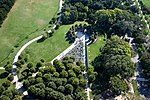Lincoln Memorial Reflecting Pool
1923 establishments in Washington, D.C.AC with 0 elementsFountains in Washington, D.C.Monuments and memorials to Abraham Lincoln in the United StatesNational Mall ... and 1 more
Ponds of the United States

The Lincoln Memorial Reflecting Pool is the largest of the many reflecting pools in Washington, D.C., United States. It is a long and large rectangular pool located on the National Mall, directly east of the Lincoln Memorial, with the Washington Monument to the east of the reflecting pool. Part of the iconic image of Washington, the reflecting pool hosts many of the 24 million visitors a year who visit the National Mall. It is lined by walking paths and shade trees on both sides. Depending on the viewer's vantage point, it dramatically reflects the Washington Monument, the Lincoln Memorial, the Mall's trees, and/or the expansive sky.
Excerpt from the Wikipedia article Lincoln Memorial Reflecting Pool (License: CC BY-SA 3.0, Authors, Images).Lincoln Memorial Reflecting Pool
Elm Walk, Washington
Geographical coordinates (GPS) Address Nearby Places Show on map
Geographical coordinates (GPS)
| Latitude | Longitude |
|---|---|
| N 38.8893 ° | E -77.045 ° |
Address
Elm Walk
Elm Walk
20227 Washington
District of Columbia, United States
Open on Google Maps










